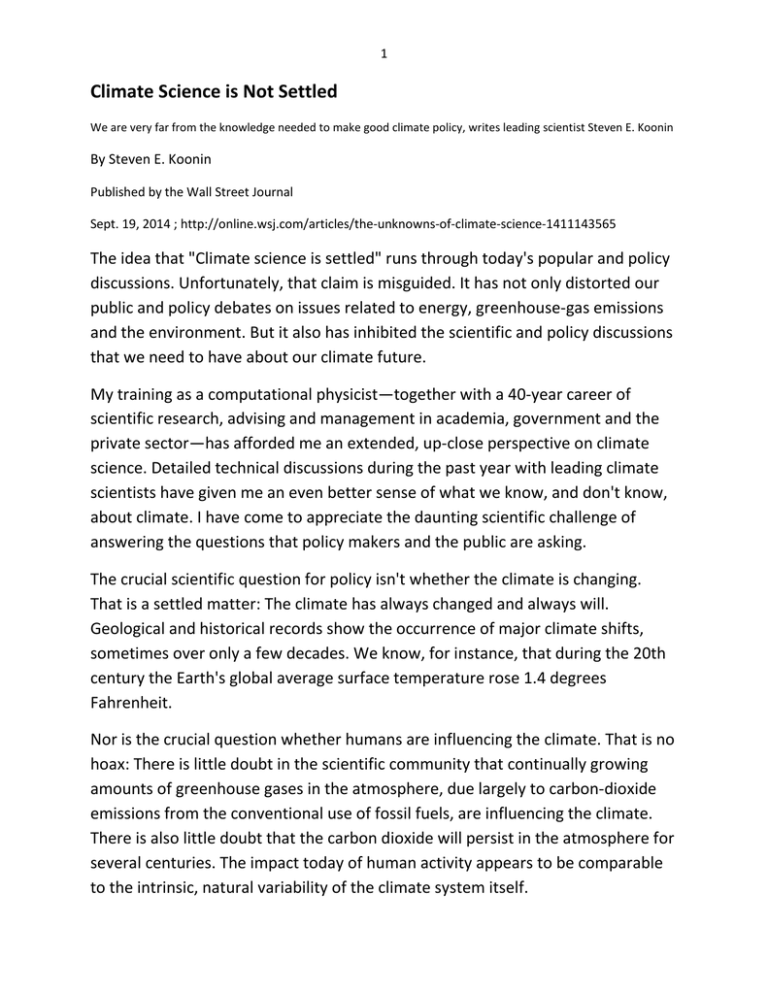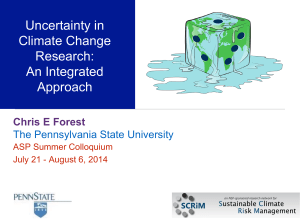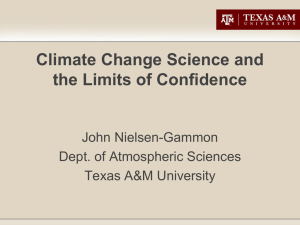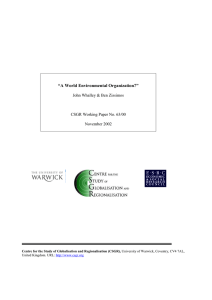Climate Science is Not Settled 1
advertisement

1
Climate Science is Not Settled
We are very far from the knowledge needed to make good climate policy, writes leading scientist Steven E. Koonin
By Steven E. Koonin
Published by the Wall Street Journal
Sept. 19, 2014 ; http://online.wsj.com/articles/the-unknowns-of-climate-science-1411143565
The idea that "Climate science is settled" runs through today's popular and policy
discussions. Unfortunately, that claim is misguided. It has not only distorted our
public and policy debates on issues related to energy, greenhouse-gas emissions
and the environment. But it also has inhibited the scientific and policy discussions
that we need to have about our climate future.
My training as a computational physicist—together with a 40-year career of
scientific research, advising and management in academia, government and the
private sector—has afforded me an extended, up-close perspective on climate
science. Detailed technical discussions during the past year with leading climate
scientists have given me an even better sense of what we know, and don't know,
about climate. I have come to appreciate the daunting scientific challenge of
answering the questions that policy makers and the public are asking.
The crucial scientific question for policy isn't whether the climate is changing.
That is a settled matter: The climate has always changed and always will.
Geological and historical records show the occurrence of major climate shifts,
sometimes over only a few decades. We know, for instance, that during the 20th
century the Earth's global average surface temperature rose 1.4 degrees
Fahrenheit.
Nor is the crucial question whether humans are influencing the climate. That is no
hoax: There is little doubt in the scientific community that continually growing
amounts of greenhouse gases in the atmosphere, due largely to carbon-dioxide
emissions from the conventional use of fossil fuels, are influencing the climate.
There is also little doubt that the carbon dioxide will persist in the atmosphere for
several centuries. The impact today of human activity appears to be comparable
to the intrinsic, natural variability of the climate system itself.
2
Rather, the crucial, unsettled scientific question for policy is, "How will the climate
change over the next century under both natural and human influences?"
Answers to that question at the global and regional levels, as well as to equally
complex questions of how ecosystems and human activities will be affected,
should inform our choices about energy and infrastructure.
But—here's the catch—those questions are the hardest ones to answer. They
challenge, in a fundamental way, what science can tell us about future climates.
Even though human influences could have serious consequences for the climate,
they are physically small in relation to the climate system as a whole. For
example, human additions to carbon dioxide in the atmosphere by the middle of
the 21st century are expected to directly shift the atmosphere's natural
greenhouse effect by only 1% to 2% [1]. Since the climate system is highly
variable on its own, that smallness sets a very high bar for confidently projecting
the consequences of human influences.
A second challenge to "knowing" future climate is today's poor understanding of
the oceans. The oceans, which change over decades and centuries, hold most of
the climate's heat and strongly influence the atmosphere. Unfortunately, precise,
comprehensive observations of the oceans are available only for the past few
decades; the reliable record is still far too short to adequately understand how
the oceans will change and how that will affect climate [2].
A third fundamental challenge arises from feedbacks that can dramatically
amplify or mute the climate's response to human and natural influences [3]. One
important feedback, which is thought to approximately double the direct heating
effect of carbon dioxide, involves water vapor, clouds and temperature.
But feedbacks are uncertain. They depend on the details of processes such as
evaporation and the flow of radiation through clouds. They cannot be determined
confidently from the basic laws of physics and chemistry, so they must be verified
by precise, detailed observations that are, in many cases, not yet available.
Beyond these observational challenges are those posed by the complex computer
models used to project future climate. These massive programs attempt to
3
describe the dynamics and interactions of the various components of the Earth
system—the atmosphere, the oceans, the land, the ice and the biosphere of living
things. While some parts of the models rely on well-tested physical laws, other
parts involve technically informed estimation [4]. Computer modeling of complex
systems is as much an art as a science.
For instance, global climate models describe the Earth on a grid that is currently
limited by computer capabilities to a resolution of no finer than 60 miles. (The
distance from New York City to Washington, D.C., is thus covered by only four grid
cells.) But processes such as cloud formation, turbulence and rain all happen on
much smaller scales. These critical processes then appear in the model only
through adjustable assumptions that specify, for example, how the average cloud
cover depends on a grid box's average temperature and humidity. In a given
model, dozens of such assumptions must be adjusted ("tuned," in the jargon of
modelers) to reproduce both current observations and imperfectly known
historical records.
We often hear that there is a "scientific consensus" about climate change. But as
far as the computer models go, there isn't a useful consensus at the level of detail
relevant to assessing human influences. Since 1990, the United Nations
Intergovernmental Panel on Climate Change, or IPCC, has periodically surveyed
the state of climate science. Each successive report from that endeavor, with
contributions from thousands of scientists around the world, has come to be seen
as the definitive assessment of climate science at the time of its issue.
For the latest IPCC report (September 2013), its Working Group I, which focuses
on physical science, uses an ensemble of some 55 different models [5]. Although
most of these models are tuned to reproduce the gross features of the Earth's
climate, the marked differences in their details and projections reflect all of the
limitations that I have described. For example:
• The models differ in their descriptions of the past century's global average
surface temperature by more than three times the entire warming recorded
during that time [6]. Such mismatches are also present in many other basic
climate factors, including rainfall, which is fundamental to the atmosphere's
4
energy balance [7]. As a result, the models give widely varying descriptions of the
climate's inner workings. Since they disagree so markedly, no more than one of
them can be right.
• Although the Earth's average surface temperature rose sharply by 0.9 degree
Fahrenheit during the last quarter of the 20th century, it has increased much
more slowly for the past 16 years, even as the human contribution to atmospheric
carbon dioxide has risen by some 25%. This surprising fact demonstrates directly
that natural influences and variability are powerful enough to counteract the
present warming influence exerted by human activity.
Yet the models famously fail to capture this slowing in the temperature rise [8].
Several dozen different explanations for this failure have been offered, with
ocean variability most likely playing a major role. But the whole episode continues
to highlight the limits of our modeling.
• The models roughly describe the shrinking extent of Arctic sea ice observed over
the past two decades, but they fail to describe the comparable growth of
Antarctic sea ice [9], which is now at a record high.
• The models predict that the lower atmosphere in the tropics will absorb much
of the heat of the warming atmosphere. But that "hot spot" has not been
confidently observed, casting doubt on our understanding of the crucial feedback
of water vapor on temperature [10].
• Even though the human influence on climate was much smaller in the past, the
models do not account for the fact that the rate of global sea-level rise 70 years
ago was as large as what we observe today—about one foot per century [11].
• A crucial measure of our knowledge of feedbacks is climate sensitivity—that is,
the warming induced by a hypothetical doubling of carbon-dioxide concentration.
Today's best estimate of the sensitivity (between 2.7 degrees Fahrenheit and 8.1
degrees Fahrenheit) is no different, and no more certain, than it was 30 years ago
[12]. And this is despite an heroic research effort costing billions of dollars.
These and many other open questions are in fact described in the IPCC research
reports, although a detailed and knowledgeable reading is sometimes required to
5
discern them. They are not "minor" issues to be "cleaned up" by further research.
Rather, they are deficiencies that erode confidence in the computer projections.
Work to resolve these shortcomings in climate models should be among the top
priorities for climate research.
Yet a public official reading only the IPCC's "Summary for Policy Makers" would
gain little sense of the extent or implications of these deficiencies. These are
fundamental challenges to our understanding of human impacts on the climate,
and they should not be dismissed with the mantra that "climate science is
settled."
While the past two decades have seen progress in climate science, the field is not
yet mature enough to usefully answer the difficult and important questions being
asked of it. This decidedly unsettled state highlights what should be obvious:
Understanding climate, at the level of detail relevant to human influences, is a
very, very difficult problem.
We can and should take steps to make climate projections more useful over time.
An international commitment to a sustained global climate observation system
would generate an ever-lengthening record of more precise observations. And
increasingly powerful computers can allow a better understanding of the
uncertainties in our models, finer model grids and more sophisticated
descriptions of the processes that occur within them. The science is urgent, since
we could be caught flat-footed if our understanding does not improve more
rapidly than the climate itself changes.
A transparent rigor would also be a welcome development, especially given the
momentous political and policy decisions at stake. That could be supported by
regular, independent, "red team" reviews to stress-test and challenge the
projections by focusing on their deficiencies and uncertainties; that would
certainly be the best practice of the scientific method. But because the natural
climate changes over decades, it will take many years to get the data needed to
confidently isolate and quantify the effects of human influences.
Policy makers and the public may wish for the comfort of certainty in their climate
science. But I fear that rigidly promulgating the idea that climate science is
6
"settled" (or is a "hoax") demeans and chills the scientific enterprise, retarding its
progress in these important matters. Uncertainty is a prime mover and motivator
of science and must be faced head-on. It should not be confined to hushed
sidebar conversations at academic conferences.
Society's choices in the years ahead will necessarily be based on uncertain
knowledge of future climates. That uncertainty need not be an excuse for
inaction. There is well-justified prudence in accelerating the development of lowemissions technologies and in cost-effective energy-efficiency measures.
But climate strategies beyond such "no regrets" efforts carry costs, risks and
questions of effectiveness, so nonscientific factors inevitably enter the decision.
These include our tolerance for risk and the priorities that we assign to economic
development, poverty reduction, environmental quality, and intergenerational
and geographical equity.
Individuals and countries can legitimately disagree about these matters, so the
discussion should not be about "believing" or "denying" the science. Despite the
statements of numerous scientific societies, the scientific community cannot
claim any special expertise in addressing issues related to humanity's deepest
goals and values. The political and diplomatic spheres are best suited to debating
and resolving such questions, and misrepresenting the current state of climate
science does nothing to advance that effort.
Any serious discussion of the changing climate must begin by acknowledging not
only the scientific certainties but also the uncertainties, especially in projecting
the future. Recognizing those limits, rather than ignoring them, will lead to a
more sober and ultimately more productive discussion of climate change and
climate policies. To do otherwise is a great disservice to climate science itself.
Dr. Koonin was undersecretary for science in the Energy Department during
President Barack Obama's first term and is currently director of the Center for
Urban Science and Progress at New York University. His previous positions include
professor of theoretical physics and provost at Caltech, as well as chief scientist of
BP, where his work focused on renewable and low-carbon energy technologies.
7
Notes
[AR5 WG1 = IPCC Fifth Assessment Report, Working Group 1;
available at http://www.ipcc.ch/report/ar5/wg1/ ]
[1] AR5 WG1 Figure 2.11 shows the global radiative balance, with the total downward flux on
the Earth’s surface estimated as 503 ± 7 W/m2 (161 W/m2 solar + 342 W/m2 thermal). AR5
Figure SPM.4 shows the total anthropogenic direct perturbation of this balance to be some 2.3 ±
1 W/ m2, less than 0.5% of the downward flux. If the atmospheric concentration of CO2 were to
rise to 550 ppm with all other anthropogenic effects unchanged, this perturbation would rise to
be 3.9 W/ m2.
[2] See AR5 WG1 Figure 3.A.2 . Also, §3.6.6 states:
Given the short duration of direct measurements of ocean circulation, we have very low
confidence that multi-decadal trends can be separated from decadal variability.
[3] AR5 WG1 §TFE.6. See also http://en.wikipedia.org/wiki/Climate_change_feedback
[4] For example, from AR5 WG1 SPM §D.1:
Climate models now include more cloud and aerosol processes, and their interactions, than at the
time of the AR4, but there remains low confidence in the representation and quantification of
these processes in models. {7.3, 7.6, 9.4, 9.7}
Also see AR5 WG1 §7.2.3.
[5] The list of models is given in AR5 WG1 Table 9.1.
[6] AR5 WG1 Figure 9.8 panel insets.
[7] See, for example, AR5 WG1 Figures 9.39 and 9.40 for the spreads in precipitation and AR5
WG1 Figure 9.36 for the spread in ENSO response.
[8] AR5 WG1 SPM §D.1 contains a rather confusing explanation of the “hiatus”:
The observed reduction in surface warming trend over the period 1998–2012 as compared to the
period 1951–2012, is due in roughly equal measure to a reduced trend in radiative forcing and a
cooling contribution from internal variability, which includes a possible redistribution of heat
within the ocean (medium confidence). The reduced trend in radiative forcing is primarily due to
volcanic eruptions and the timing of the downward phase of the 11-year solar cycle. However,
there is low confidence in quantifying the role of changes in radiative forcing in causing the
reduced warming trend. There is medium confidence that internal decadal variability causes to a
substantial degree the difference between observations and the simulations; the latter are not
expected to reproduce the timing of internal variability. There may also be a contribution from
forcing inadequacies and, in some models, an overestimate of the response to increasing
8
greenhouse gas and other anthropogenic forcing (dominated by the effects of aerosols). {9.4, Box
9.2, 10.3, Box 10.2, 11.3}
[9] AR5 WG1 SPM §D.1:
There is robust evidence that the downward trend in Arctic summer sea ice extent since 1979 is
now reproduced by more models than at the time of the AR4, with about one-quarter of the
models showing a trend as large as, or larger than, the trend in the observations. Most models
simulate a small downward trend in Antarctic sea ice extent, albeit with large inter-model spread,
in contrast to the small upward trend in observations. {9.4}
It is interesting to compare the last sentence to the wording in the WG1 report itself (§ 9.4.3.1):
Most CMIP5 models simulate a decrease in Antarctic sea ice extent over the past few decades
compared to the small but significant increase observed
[10] AR5 WG1 §9.4.1.4.2:
In summary, most, though not all, CMIP3 and CMIP5 models overestimate the observed
warming trend in the tropical troposphere during the satellite period 1979–2012. Roughly onehalf to two-thirds of this difference from the observed trend is due to an overestimate of the SST
trend, which is propagated upward because models attempt to maintain static stability. There is
low confidence in these assessments, however, due to the low confidence in observed tropical
tropospheric trend rates and vertical structure (Section 2.4.4).
[11] AR5 WG1 SPM §B.4:
It is likely that similarly high rates [of global averaged sea level rise] occurred between 1920 and
1950 [as those from 1993-2010]. {3.7}
See also AR5 WG1 §13.3.6.
[12] IPCC’s latest assessment (AR5 WG1 §TS.5.3) of ECS is 1.5-4.5 °C (66% CI). It is notable
that this estimate is not derived from hard science, but rather from “expert assessment” (AR5
WG1, p. TS-56).






